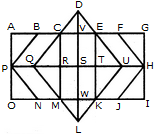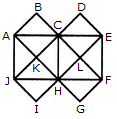
Determine the number of rectangles and hexagons in the given figure.
30, 5
32, 3
28, 5
30, 3
Correct answer is A

The figure may be labelled as shown.
Rectangles:
The simplest rectangles are CVSR, VETS, RSWM and STKW i.e. 4 in number.
The rectangles composed of two components each are CETR, VEKW, RTKM and CVWM i.e. 4 in number.
The rectangles composed of three components each are ACRP, PRMO, EGHT and THIK i.e. 4 in number.
The rectangles composed of four components each are CEKM, AVSP,PSWO, VGHS and SHIW i.e. 5 in number.
The rectangles composed of five components each are AETP, PTKO, CGHR and RHIM i.e. 4 in number.
The rectangles composed of six components each are ACMO and EGIK i.e. 2 in number.
The rectangles composed of eight components each are AGHP, PHIO, AVWO and VGIW i.e. 4 in number.
The rectangles composed of ten components each are AEKO and CGIM i.e. 2 in number.
AGIO is the only rectangle having sixteen components.
Total number of rectangles in the given figure
= 4 + 4 + 4 + 5 + 4 + 2 + 4 + 2 + 1 = 30.
Hexagons:
The hexagons in the given figure are CDEKLM, CEUKMQ, CFHJMQ, BEUKNP and BFHJNP.
So, there are 5 hexagons in the given figure.

How many rectangles are there in the given figure.
10
9
8
7
Correct answer is B

The figure may be labelled as shown.
The simplest rectangles are ABJI, BCKJ, IJFG and JKEF i.e. 4 in number.
The rectangles composed of two components each are ACKI, BCEF, IKEG and ABFG i.e. 4 in number.
The only rectangle composed of four components is ACEG.
Thus, there are 4 + 4 + 1 = 9 rectangles in the given figure.

What is the minimum number of straight lines that is needed to construct the figure?
11
13
15
21
Correct answer is B

The figure may be labelled as shown.
The horizontal lines are AE and JF i.e. 2 in number. The vertical lines are AJ, CH and EF i.e. 3 in number.
The slanting lines are AG, BF, JD, IE, AB, DE, JI and FG i.e. 8 in number.
Total number of straight lines needed to construct the figure = 2 + 3 + 8 = 13.

Count the number of squares in the given figure.
18
19
25
27
Correct answer is D

The figure may be labelled as shown.
The simplest squares are EFRQ, MQYX, QRZY, RNSZ, LXWK, XYA1W, YZB1A1, ZSTB1, SGHT, WA1VP, A1B1UV, B1TOU and VUIJ i.e. 13 in number.
The squares having two components each are AEYL, FBGZ, KA1JD and B1HCI i.e. 4 in number.
The squares having four components each are MRB1W, QNTA1 XZUP and YSOV i.e. 4 in number.
The squares having seven components each are AFB1K, EBHA1 LZID and YGCJ i.e. 4 in number.
There is only one square i.e. MNOP composed of nine components.
There is only one square i.e. ABCD composed of seventeen components.
There are 13+ 4 + 4 + 4+1 + 1 = 27 squares in the figure.

Count the number of parallelogram in the given figure.
23
22
21
18
Correct answer is A

The figure may be labelled as shown.
The simplest parallelograms are EMLA and NIDJ i.e. 2 in number.
The parallelograms composed of two components each are BFMG, CGNH, GMKN, FGME, GHNM, MNKL, FGNM, GHIN and MNJK i.e. 9 in number.
The parallelograms composed of three components each are FGLA, ENKA, GHDJ and MIDK ie. 4 in number.
The parallelograms composed of four components each are FGJK, GHKL, FBNK, CHKM, EFHN and MFHI i.e. 6 in number.
The parallelograms composed of seven components each are FHKA and FHDK i.e. 2 in number.
Total number of parallelograms in the figure = 2 + 9 + 4 + 6 + 2 = 23.
Aptitude Tests